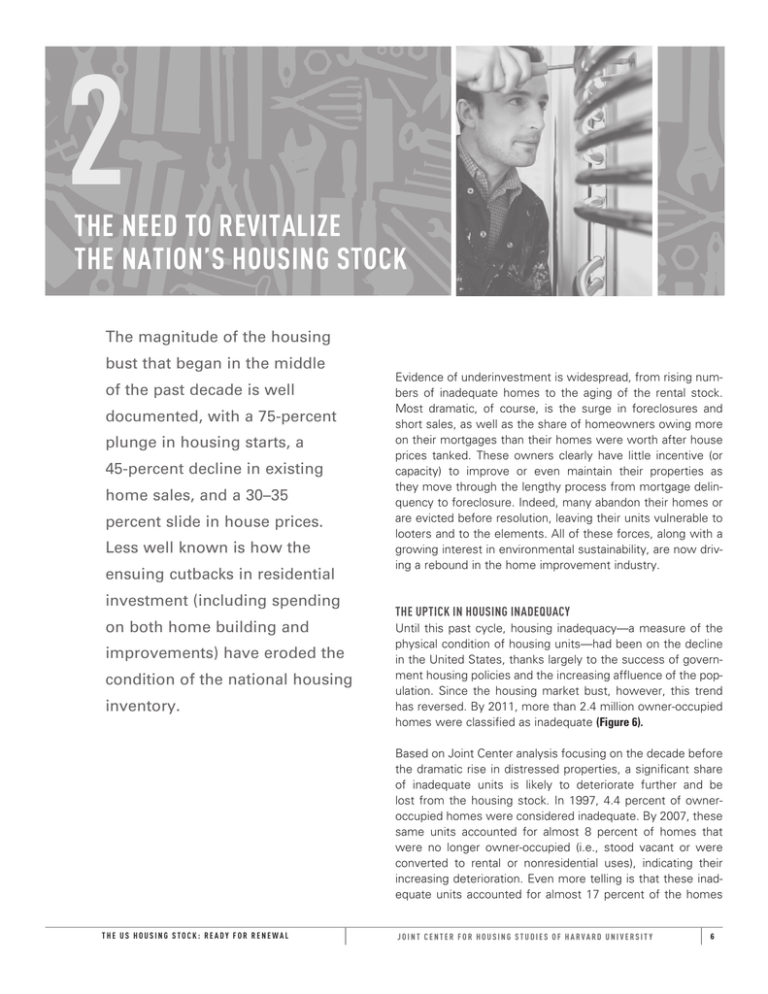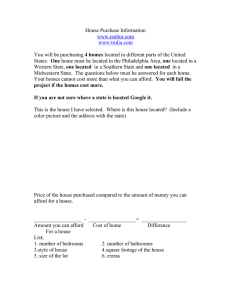2 THE NEED TO REVITALIZE THE NATION’S HOUSING STOCK
advertisement

2 THE NEED TO REVITALIZE THE NATION’S HOUSING STOCK The magnitude of the housing bust that began in the middle of the past decade is well documented, with a 75-percent plunge in housing starts, a 45-percent decline in existing home sales, and a 30–35 percent slide in house prices. Less well known is how the ensuing cutbacks in residential investment (including spending on both home building and improvements) have eroded the condition of the national housing inventory. Evidence of underinvestment is widespread, from rising numbers of inadequate homes to the aging of the rental stock. Most dramatic, of course, is the surge in foreclosures and short sales, as well as the share of homeowners owing more on their mortgages than their homes were worth after house prices tanked. These owners clearly have little incentive (or capacity) to improve or even maintain their properties as they move through the lengthy process from mortgage delinquency to foreclosure. Indeed, many abandon their homes or are evicted before resolution, leaving their units vulnerable to looters and to the elements. All of these forces, along with a growing interest in environmental sustainability, are now driving a rebound in the home improvement industry. THE UPTICK IN HOUSING INADEQUACY Until this past cycle, housing inadequacy—a measure of the physical condition of housing units—had been on the decline in the United States, thanks largely to the success of government housing policies and the increasing affluence of the population. Since the housing market bust, however, this trend has reversed. By 2011, more than 2.4 million owner-occupied homes were classified as inadequate (Figure 6). Based on Joint Center analysis focusing on the decade before the dramatic rise in distressed properties, a significant share of inadequate units is likely to deteriorate further and be lost from the housing stock. In 1997, 4.4 percent of owneroccupied homes were considered inadequate. By 2007, these same units accounted for almost 8 percent of homes that were no longer owner-occupied (i.e., stood vacant or were converted to rental or nonresidential uses), indicating their increasing deterioration. Even more telling is that these inadequate units accounted for almost 17 percent of the homes THE US HOUSING STOCK: READY FOR RENEWAL JOINT CENTER F OR HOUSING STUDIES OF HARVARD UNIVERSIT Y 6 Figure 6 Housing Inadequacy Has Been on the Rise Since the Housing Market Bust Number of Owner-Occupied Homes Classified as Moderately or Severely Inadequate (Millions) 4 3.24 3 2.89 2.93 2.82 2.70 2.52 2 2.27 2.42 2.43 1 0 1995 1997 1999 2001 2003 2005 2007 2009 2011 Notes: A housing unit is defined as inadequate if it lacks complete kitchen or bathroom facilities or running water, as well as shows signs of disrepair such as leaks, holes, and broken systems. For a complete definition, see the US Department of Housing and Urban Development’s Codebook for the American Housing Survey, Public Use File: 1997 and Later. Source: JCHS tabulations of the 1995–2011 AHS. Figure 7 Home Improvement Spending on Distressed Properties Hit Nearly $10 Billion in 2011 tbd Number of Distressed Properties Improved Average Expenditure per Unit Total Market Spending (Billions) Bank-Owned (Pre-sale) 260,000 $6,500 $1.7 Homeowners (Post-sale) 380,000 $11,100 $4.2 Investors (Post-sale) 250,000 $15,600 $3.9 Total Spending $9.8 onto the housing market in 2011, including 760,000 lenderowned units and 300,000 short sales. According to Joint Center research, institutional sellers made improvements to about a third of their foreclosed properties prior to sale, with an average expenditure of about $6,500 per unit (Figure 7). About 60 percent of owner-occupant purchasers undertook improvements averaging $11,100, while investors spent even more per unit on average. In total, spending on distressed properties added almost $10 billion to home improvement expenditures for the year. Given several years of underinvestment, however, it is difficult to know if this catch-up spending was enough to stem the likely deterioration of these properties. Renovating foreclosed or abandoned homes benefits the entire neighborhood. Joint Center research has shown that home prices in neighborhoods with higher levels of improvement spending appreciate more rapidly,1 explaining why investing in blighted neighborhoods has been a national priority in dealing with the foreclosure crisis. HUD’s Neighborhood Stabilization Program, for example, earmarked almost $7 billion for local initiatives to help minimize the impact of distressed properties on broader neighborhood conditions. Local home improvement assistance programs—with the support of national nonprofits such as NeighborWorks America, Enterprise Community Partners, Local Initiatives Support Corporation, and Rebuilding Together—also make neighborhood stabilization a goal. As a recent survey of participants in the Rebuilding Together program revealed, nearly two-thirds of respondents had lived in their current homes for at least 20 years and were spending well below the national average amount on home improvements and repairs.2 Without this assistance, their homes would deteriorate and potentially have spillover effects on surrounding properties. Moreover, many of these older owners might be forced to move from their homes because they could no longer live there safely given their physical limitations. Note: Bank-owned distressed properties include those sold by Fannie Mae, Freddie Mac, FHA, or private banks. Source: Elizabeth La Jeunesse, Home Improvement Spending on Distressed Properties: 2011 Estimates, JCHS working paper, forthcoming. that were demolished within the decade. Loss rates since the housing bust are likely even higher. As the broader economy recovers and housing markets tighten, however, some of these inadequate homes will likely be renovated to provide affordable housing opportunities. REHABILITATING FORECLOSED HOMES The good news is that new owners are investing in foreclosed homes. More than a million distressed properties came back THE US HOUSING STOCK: READY FOR RENEWAL RENEWED INTEREST IN THE RENTAL STOCK Investors are also buying up distressed properties and converting the units to rentals. Including these conversions, 4.4 million formerly owner-occupied units were shifted to the rental market between 2007 and 2011. Another 4.6 million were vacant in 2011 and may (at least temporarily) become part of the rental stock as demand continues to grow. 1. Kevin Park, Good Home Improvers Make Good Neighbors, JCHS working paper W08-2, April 2008. 2. Abbe Will and Kermit Baker, The Role of Nonprofit Organizations and Public Programs in Promoting Home Improvement and Repair Activity, JCHS working paper, forthcoming. JOINT CENTER F OR HOUSING STUDIES OF HARVARD UNIVERSIT Y 7 But beyond the need to repair these converted units, there is also a need to address the aging of the overall rental stock. With the slowdown in multifamily construction during the housing boom, the median age of rental units was 39 years in 2011—some 16 years above the median in 1985. Growing demand for rental units, together with several years of underinvestment in the stock, would seem to be a formula for higher spending in this market. But as Joint Center estimates show, the expanding supply of rental units in recent years seems to have more than offset increased demand, thereby limiting the incentive to raise improvement expenditures. Between 2001 and 2007, average inflation-adjusted spending on owner-occupied units increased by 40 percent while spending on rental units showed a slight decline. Then, during the housing bust from 2007 to 2011, spending on owner-occupied units fell more than 25 percent and spending on rental units nearly matched that drop (Figure 8). The rental share of overall improvement and repair spending has therefore been shrinking. After averaging close to 25 percent of the market through the early part of the last decade, the rental share dipped to 16 percent at the peak of the housing boom and has only edged back up near 20 percent since then. However, as the excess inventory of owner units begins to recede and fewer owned units are converted to rentals, spending on the rental stock should increase. GREENING OF THE HOUSING STOCK Although investment in the existing housing stock has generally been weak since the Great Recession began, green improvement spending has remained a bright spot. As a result, the share of expenditures on projects designed to improve energy efficiency or environmental sustainability has sharply increased in recent years. These investments have led to significant improvements in residential energy use. According to a 2009 Department of Energy (DOE) survey, homes built in the 2000s consume a quarter less energy per square foot than those built before the 1970s oil embargo (Figure 9). At the same time, retrofits of older homes have also yielded steady efficiency gains, with a typical pre-1970 house using 30 percent less energy in 2009 than a similar home consumed in 1980 (Figure 10). Some of these improvements may, of course, reflect removal of less efficient homes from the stock or changes in household behavior, such as keeping homes cooler in the winter and warmer in the summer. Nevertheless, it seems safe to conclude that investments in the existing stock are largely responsible for much of the overall reduction in energy use. THE US HOUSING STOCK: READY FOR RENEWAL Figure 8 Spending on Rental Units Has Languished for More than a Decade Average Annual Improvement Spending per Unit (2011 dollars) 4,000 2,920 3,000 3,280 2,590 2,270 2,330 2,370 2,000 1,000 780 650 680 650 620 500 2005 2007 2009 2011 0 2003 2001 ■ Rental ■ Owner Sources: JCHS tabulations of 2001–07 C-50 reports; 2001–11 AHS; and Abbe Will, Estimating National Levels of Home Improvements and Repair Spending by Rental Property Owners, JCHS research note N10-2, October 2010. In 2011, about a quarter of households undertaking home improvements indicated that a goal of at least one project was to increase energy efficiency. The types of energy-efficient retrofits included exterior replacements, systems upgrades, and insulation. The 2009 DOE survey indicates that about a third of owners with homes that were at least five years old had replaced some or all of the windows with high-performance products. In addition, more than one in five had replaced their principal space-heating equipment within the previous four years, while a similar share with central air conditioning had replaced those systems as well. Given that homes account for about 22 percent of all US energy consumption, the potential benefits from additional retrofits are vast. In fact, bringing homes built before 1970 up to the efficiency levels of the newest stock would cut total residential energy use by 10 percent. Even bringing these older homes up to the efficiency of units built in the 1970s or 1980s would save about 5 percent of current residential energy consumption. Opportunities for more modest gains also abound. For example, only about 3 percent of homeowners living in units that are at least five years old have tankless water heaters. In addition, less than 1 percent of these owners rely on an on-site renewable energy source such as solar, wind, or geothermal. These innovations may become much more popular as they become more cost effective. JOINT CENTER F OR HOUSING STUDIES OF HARVARD UNIVERSIT Y 8 Figure 9 While Homes Built After the Early-1970s Oil Embargo Consume Much Less Energy… Energy Consumption per Square Foot for Owner-Occupied Homes in 2009 (Thousands of BTUs) 60 26.7 50 50 48 47 47 40 43 42 39 36 30 20 10 0 1939 or Before 1940–49 1950–59 1960–69 1970–79 1980–89 1990–99 2000–09 Year Built Note: Square footage includes heated and cooled garages, basements, and finished, heated, and cooled attics. Source: JCHS tabulations of US Department of Energy, Energy Information Administration, 2009 Residential Energy Consumption Survey (RECS). Figure 10 … Retrofits to the Existing Stock Are Responsible for Most Efficiency Gains Energy Consumption per Square Foot for Owner-Occupied Homes (Thousands of BTUs) 80 70 60 50 40 30 20 10 0 1939 or Before 1940–49 1950–59 1960–69 1970–79 1980–89 1990–99 2000–09 Year Built Survey Year: ■ 1980 ■ 1990 ■ 2001 ■ 2009 Note: Square footage includes attached garages, basements, and finished, heated, and cooled attics. Source: JCHS tabulations of 1980–2009 RECS. The rental stock offers particularly large opportunities for energy savings. Today, owners of rental units have little incentive to upgrade energy efficiency if renters pay utility costs. For their part, renters have little incentive to make such investments because they only benefit from the improvements while they occupy the unit. They have even less incentive if they do not directly pay for utilities. As a result, energy consumption per square foot for units where the rent included THE US HOUSING STOCK: READY FOR RENEWAL utility costs was almost 50 percent higher in 2009 than for units where the renter paid these costs. But even when renters were responsible for utilities, their units used almost 20 percent more energy on average than owner-occupied homes. While energy efficiency is a high priority, consumers also have a growing interest in environmental sustainability. In recent Joint Center surveys, remodeling contractors reported JOINT CENTER F OR HOUSING STUDIES OF HARVARD UNIVERSIT Y 9 that high-efficiency toilets, low- or no-VOC paints, and moldresistant gypsum wall panels are among the most popular green products used in home improvement projects. In 2012, the share of remodeling revenues from projects promoting environmental sustainability (24 percent) approached the share from projects designed to increase energy efficiency (32 percent). In many cases, of course, projects were designed to address multiple goals. Products for the environmental sustainability market continue to advance. For example, the widespread use of connected devices—such as computers, smart phones, and tablets— provides significant opportunities for households to manage resources more efficiently. While smart systems are much easier to install when homes are being built, demand for retrofits will no doubt grow once the technology is better developed and less expensive. Momentum is also building in the healthy home movement, which seeks to eliminate the use of toxic materials in home construction and renovation. With research suggesting that healthy homes can reduce medical costs, a new industry is developing around the retrofit activities that can mitigate air pollution and other hazards within the home. OPPORTUNITIES FOR REMODELERS Years of underinvestment in the nation’s housing stock have expanded the market for home improvements. In particular, the growing supply of homes that have been through the pro- THE US HOUSING STOCK: READY FOR RENEWAL tracted foreclosure process represents a major opportunity for remodeling firms. In 2011 alone, renovations of just over a million distressed properties generated about $10 billion in spending. With nearly 3 million additional homes currently in or at risk of foreclosure, many more billions will be necessary to upgrade these properties for return to the market. The nation’s aging rental stock also represents a huge potential market. In addition to the need to modernize older units, there is also an emerging opportunity to convert units that were shifted to the rental market during the housing bust back to the owner-occupied stock. These re-conversions are likely to spark higher improvement spending. Indeed, recent expenditures on single-family detached rental units in 2007 that were converted to owner occupancy by 2009 were about 18 percent higher on average than for homes that remained owner-occupied from 2007 to 2011. Finally, improvement projects intended to increase environmental sustainability are likely to account for a growing share of remodeling spending. Home builder efforts in this realm are already paying off in the marketplace, with some buyers paying premiums of nearly 10 percent for new homes carrying a green certification. Comparable certification programs for existing homes should also boost consumer demand and therefore price premiums. In addition, federally backed green mortgages—which help homebuyers qualify for loans to purchase homes that meet specific energy-efficiency guidelines—may also encourage buyers of existing homes to spend more on retrofits. JOINT CENTER F OR HOUSING STUDIES OF HARVARD UNIVERSIT Y 10



